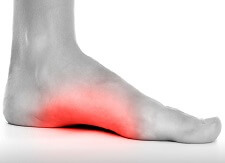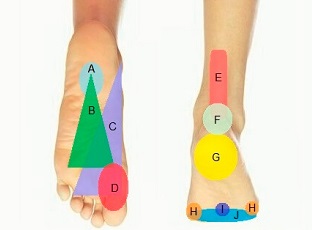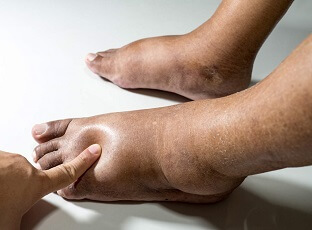- Home
- Diagnosis Guide
- Toe Pain
- Hallux Rigidus
Hallux Rigidus
Written By: Chloe Wilson BSc(Hons) Physiotherapy
Reviewed By: FPE Medical Review Board
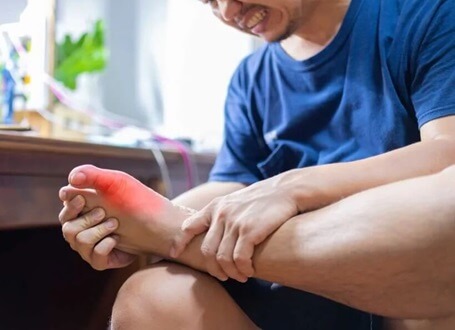
Hallux rigidus is a common cause of pain and stiffness in the big toe.
It is the most common type of foot arthritis and can affect daily activities such as walking, running and climbing stairs.
Hallux rigidus typically affects people over the age of 50 and tends to get progressively worse with time.
In most cases, hallux rigidus symptoms can be effectively managed with simple home treatments such as ice, medication, changing footwear and shoe inserts. But in more severe cases, surgery may be recommended.
Here we will look at what is going on in the big toe joint, the common causes and symptoms, how it is diagnosed and the best treatment options for hallux rigidus.
What is Hallux Rigidus?
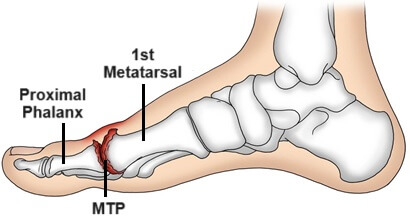
Hallux rigidus is a degenerative condition that affects the joint at the base of the big toe, known as the metatarsophalangeal joint (MTP).
The MTP joint is where the first long foot bone (1st metatarsal) meets the first toe bone (proximal phalanx).
The MTP is a really important joint as not only does it allow the toe to bend, it also helps the big toe grip the ground and provide leverage when walking and running as well as playing an important role in balance.
Hallux rigidus simply means "stiff big toe" and is the most common type of foot arthritis. It is characterized by the progressive loss of motion in the MTP joint, resulting in stiffness and discomfort. There are a number of arthritic changes that occur in the big toe with hallux rigidus:
- Degeneration of Articular Cartilage: One of the hallmark features of hallux rigidus is the progressive degeneration of the articular cartilage within the MTP joint. Articular cartilage is the smooth, protective covering over the ends of bones in a joint. In hallux rigidus, this cartilage gradually breaks down, leading to friction and increased joint stiffness.
- Bone Spurs Formation: As the cartilage wears away, the body's response is to form new bone growth, known as osteophytes or bone spurs. These bony growths typically develop on the top of the metatarsal bone and the head of the proximal phalanx of the big toe. These spurs can further limit joint movement and cause pain when the joint moves.
- Reduced Joint Space: As the condition progresses, the joint space between the metatarsal bone and the phalanx decreases due to the increasing growth of the bone spurs and destruction of the cartilage. This reduction in joint space can result in a significant decrease in the range of motion of the big toe, causing increasing stiffness and discomfort.
- Inflammation: The increased friction between the bones and the inflammation associated with cartilage breakdown and bone spur formation leads to swelling in the joint.
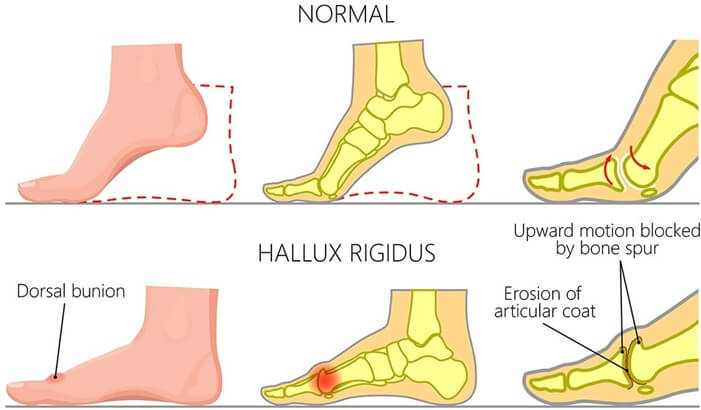
Hallux Rigidus Causes
There are a number of things that can cause hallux rigidus:
- Wear and Tear: Over time, normal wear and tear on the joint can lead to the development of hallux rigidus. The metatarsophalangeal (MTP) joint is constantly subjected to mechanical stress during walking, running, and other weight-bearing activities. This ongoing pressure can cause the cartilage in the joint to wear down gradually, particularly in very active people.
- Injury: Trauma or injury to the big toe joint can be a significant factor in the development of hallux rigidus. This may include a direct impact on the joint, such as stubbing the toe or injuring it during sports activities. Such injuries can accelerate the degenerative changes in the joint.
- Genetics: Genetics plays a role in various foot conditions, including hallux rigidus. If you have a family history of this condition or other foot deformities, you may be more predisposed to developing hallux rigidus.
- Abnormal Foot Mechanics: Individuals with certain foot abnormalities are at a higher risk of developing hallux rigidus. For example, having flat feet (pes planus) can cause excessive pronation (inward rolling of the foot) during walking, which can put extra stress on the big toe joint. Alternatively, having high-arched feet may lead to excessive supination (outward rolling of the foot), increasing the load on the big toe joint.
- Inflammatory Conditions: Certain inflammatory conditions, such as gout or rheumatoid arthritis, can contribute to the development of hallux rigidus. Inflammatory joint diseases can cause the cartilage in the MTP joint to break down more quickly, leading to stiffness and pain.
- Improper Footwear: Wearing shoes that are too tight, narrow, or have high heels can force the toes into unnatural positions. This can increase the pressure on the MTP joint and contribute to the development of hallux rigidus.
Hallux Rigidus Symptoms
The most common symptoms of hallux rigidus are:
- Stiffness: the most prominent and defining symptom of hallux rigidus is stiffness in the big toe joint. Initially, you may notice mild stiffness, but over time it tends to worsen and the range of motion in the joint becomes increasingly limited. This stiffness can significantly impact daily activities, such as walking, running, and even bending the toe during activities like squatting or climbing stairs.
- Pain: foot pain is a common and often distressing symptom of hallux rigidus. The pain is typically localized to the big toe joint, particularly on top of the toe, and it can vary in intensity from mild discomfort to sharp, stabbing pain. Hallux rigidus pain is usually exacerbated during activities that involve pushing off the toes, as this puts extra pressure on the affected joint. This discomfort can also persist at rest, especially if the condition is more advanced.
- Swelling: Inflammation is a common response to the degenerative changes occurring in the big toe joint with wear and tear. Swelling may develop around the joint, leading to increased discomfort and making it difficult to fit into tight footwear. Hallux rigidus swelling can be particularly noticeable after extended periods of activity. A lump may form on top of the big toe joint
- Difficulty Wearing Certain Footwear: As the condition progresses, individuals with hallux rigidus may find it increasingly challenging to wear shoes with narrow or pointed toe boxes. This is because the deformity in the joint and the presence of bone spurs can make it uncomfortable to have pressure on the affected area.
- Corns and Calluses: The structural changes in the big toe joint can lead to the development of corns and calluses. These areas of thickened skin often form on the tops of the toes or the sides of the foot due to friction and pressure caused by improper joint alignment.
- Changes in Gait: Hallux rigidus can alter your walking pattern. To compensate for the limited range of motion in the big toe joint, you may change the way they walk, which can lead to discomfort or pain in other areas of the foot, such as the ball of the foot or the arch.
- Joint Dysfunction: As the condition advances, the big toe may become increasingly immobile, making simple tasks like bending the toe or propelling forward during walking more difficult. This joint dysfunction can have a significant impact on overall mobility and quality of life.
It's important to remember that the severity of symptoms can vary from person to person, and some individuals may have only mild or occasional discomfort, while others may experience more pronounced and constant pain and stiffness. Early diagnosis and appropriate management can help alleviate these symptoms and maintain or restore foot function.
Diagnosis
Diagnosing hallux rigidus typically involves a combination of:
Medical History
Your healthcare provider will start by taking a detailed medical history. The will ask about your symptoms, including the duration and severity of pain, any previous injuries to the foot, family history of foot conditions, and any relevant medical conditions or treatments.
Physical Examination
They will then conduct a thorough physical examination of the foot, paying specific attention to the big toe and the metatarsophalangeal (MTP) joint. The will focus on things like range of motion and flexibility in the joints as well as noting any areas of pain, tenderness or inflammation.
Imaging Studies
In some cases, medical imaging may be recommended to confirm the diagnosis and assess the extent of the condition. Common imaging studies used for diagnosing hallux rigidus include:
- X-rays: X-ray images are an essential diagnostic tool with hallux rigidus giving a clear visual representation of the condition. They can reveal the extent of joint degeneration, the presence of bone spurs, and the alignment of the bones in the big toe joint.
- MRI (Magnetic Resonance Imaging): While not typically required for most cases of hallux rigidus, an MRI may be used if there are complexities or uncertainties regarding the diagnosis. MRI can provide more detailed images of soft tissues and the joint structures.
Differential Diagnosis
There are a number of other conditions that can present in a similar way to hallux rigidus.
- Gout: a type of arthritis where uric acid crystals build up in the big toe joint. Causes sudden intense pain, inflammation, redness and warmth in the big toe
- Turf Toe: a sprain of one of the big toe ligaments, usually caused by the toe being forced back too far e.g. sporting injury
- Sesamoiditis: inflammation of the two pea-sized bones underneath the big toe. With sesamoiditis the pain tends to be under the big toe rather than on top of it
- Bursitis: inflammation of one of the small sacs that sit between the soft tissues and bones to provide cushioning and reduce friction
- Hallux Valgus: aka bunion, where the big toe deviates towards the second toe, causing a large hard bump on the side of the big toe
- Hammer/Claw/Mallet Toe: deformities in the toe joints cause abnormal curling of the toes
You can find out more about the causes, symptoms and treatment of these conditions in the toe joint pain section.
#CommissionEarned from Amazon on qualifying purchases
Hallux Rigidus Treatment
Conservative treatments for hallux rigidus are non-surgical approaches aimed at relieving pain, reducing inflammation, and improving joint function. Common conservative treatments for hallux rigidus include:
1. Footwear
Wearing appropriate footwear is a fundamental aspect of managing hallux rigidus. The right shoes can reduce pressure on the big toe joint and alleviate pain. When choosing shoes for hallux rigidus consider:
- Wide Toe Box: Choose shoes with a wide and roomy toe box to provide space for the toes, reducing pressure on the affected joint.
- Low Heels: Opt for shoes with low or no heels, as high heels can tilt the body forward, increasing pressure on the big toe joint.
- Arch Support: Supportive shoes with proper arch support can help distribute body weight more evenly and reduce stress on the MTP joint.
Sketchers are one of the most popular brands for people with foot problems are they tend to be wide, cushioned and supportive.
2. RICE Therapy
PRICE (rest, ice compression, elevation) is a great place to start when treating hallux rigidus:
- Protect & Rest: Taking a break from activities that worsen symptoms can help reduce strain on the big toe joint. For example, if certain sports or exercises lead to increased pain, it may be necessary to temporarily reduce or eliminate those activities from your routine.
- Ice: Applying cold packs to the affected area can help reduce pain and inflammation. It's essential to wrap the ice pack in a cloth to avoid direct contact with the skin and to limit icing to 15-20 minutes at a time.
- Compression: Using a compression bandage such as tubigrip can help control any swelling and provide support to the joint.
- Elevation: Elevating the foot, especially when at rest, can help reduce swelling e.g. with a leg cushion.
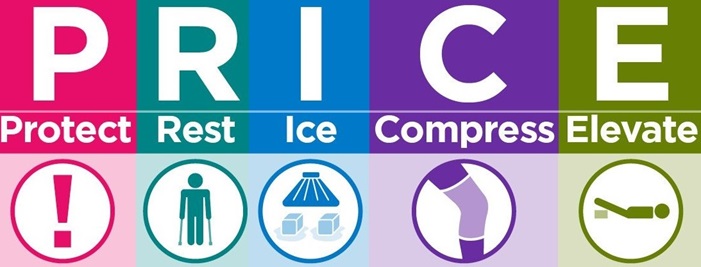
3. Medications
Non-steroidal anti-inflammatory drugs (NSAIDs) like ibuprofen or naproxen, can be used to reduce pain and inflammation. However, they are typically used for short-term relief and should be taken as directed by a healthcare professional.
4. Hallux Rigidus Orthotics
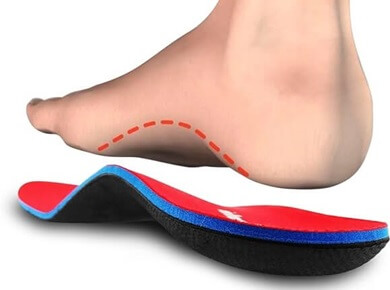
Orthotic inserts, whether custom-made or over-the-counter, can be used to improve foot biomechanics and reduce strain on the big toe joint.
Hallux rigidus orthotics work by providing additional support, stability, and cushioning to the foot, and can help distribute the pressure more evenly which can alleviate pain and promote better alignment.
Commonly used hallux rigidus orthotics include:
- Toe Spacers or Splints: can help improve toe alignment and alleviate pressure on the big toe joint. They can also support the big toe and limit motion. These can be particularly useful for individuals with mild hallux rigidus.
- Metatarsal Pads: Some shoe inserts come with metatarsal pads designed to offload pressure from the big toe joint. These can provide additional comfort and support in appropriate footwear.
- Arch Supports: can provide additional cushioning and support the foot arches to help improve foot position.
Orthotics are particularly helpful in the early stages with mild cases of hallux rigidus.
5. Physical Therapy
Physical therapy can be highly beneficial for individuals with hallux rigidus. A physical therapist can provide exercises and techniques to:
- Improve joint mobility and range of motion in the big toe
- Strengthen the muscles that support the big toe joint
- Enhance overall foot and lower limb mechanics
- Develop gait modifications to reduce stress on the affected joint
Find out more about foot exercises.
6. Corticosteroid Injections
In some cases, your healthcare provider may recommend a corticosteroid injection into the affected joint. These injections can provide short-term relief with hallux rigidus by reducing inflammation and alleviating pain. However, they are not a long-term solution and should be used sparingly due to potential side effects.
7. Regenerative Medicine
Some emerging treatments involve regenerative medicine techniques, such as platelet-rich plasma (PRP) injections or stem cell therapy may be beneficial with hallux rigidus. These approaches aim to stimulate the body's natural healing processes and may provide pain relief and improved joint function.
Hallux Rigidus Surgery
Surgery for hallux rigidus is usually only considered if conservative treatments fail to provide sufficient relief or when the condition is in an advanced stage.
These surgical procedures aim to alleviate pain, restore joint function, and improve quality of life.
Common surgical options for hallux rigidus include:
1. Cheilectomy
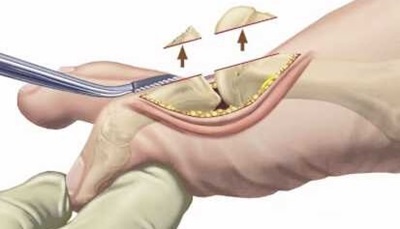
A cheilectomy is a common surgical procedure for hallux rigidus, especially in its early to mid-stages.
The primary goal of this procedure is to remove bone spurs and damaged cartilage in the metatarsophalangeal (MTP) joint of the big toe.
This creates more space within the joint, allowing for increased mobility and reduced pain. With cheilectomy hallux rigidus surgery:
- An incision is made over the MTP joint.
- The bone spurs and damaged cartilage are carefully removed and the joint is cleaned and smoothed.
- The incision is closed, and the patient is usually placed in a post-operative shoe or cast for a period of time to allow for proper healing.
2. Joint Fusion
Joint fusion, or arthrodesis, is typically the best surgical option for more advanced cases of hallux rigidus. In this procedure, the bones of the MTP joint are permanently fused together. The primary objective of joint fusion is to eliminate pain by immobilizing the joint. This prevents any motion in the MTP joint, which, in turn, eliminates the source of pain and allows the joint to heal.
In hallux rigidus joint fusion surgery:
- An incision is made over the MTP joint and the damaged joint surfaces are removed.
- The ends of the metatarsal and proximal phalanx bones are aligned properly and secured together using screws, plates, or other fixation devices.
- Over time, the bones fuse together, creating a stable and pain-free joint.
While joint fusion may result in a loss of mobility in the big toe, it can provide lasting pain relief and is a suitable option for individuals who can adapt to a different walking pattern without significant limitations.
3. Joint Replacement
Joint replacement, or arthroplasty, is a less common surgical option for hallux rigidus but may be considered in specific cases. This procedure involves the removal of the damaged joint surfaces and their replacement with artificial materials, such as metal or plastic components, to create a new joint. Arthroplasty aims to preserve joint motion while eliminating pain.
Joint replacement may be an option for individuals who wish to maintain some degree of joint mobility but may not be suitable for everyone, particularly young, active people.
The choice of surgical procedure depends on your specific needs, including the severity of the condition, activity level, and overall health. It's essential to have a thorough discussion with a healthcare provider to determine the most appropriate surgical option for hallux rigidus and to understand the potential benefits and risks associated with each procedure.
It usually takes around 3-6 months to fully recover from hallux rigidus surgery.
Hallux Rigidus Summary
- Hallux rigidus is a common cause of big toe stiffness and pain in people over the age of 50.
- Wear and tear in the big toe joint leads to joint degeneration, bone spurs and loss of joint space.
- Common causes of hallux rigidus include repetitive wear and tear, altered foot biomechanics, previous foot injuries and genetics.
- Hallux rigidus symptoms usually include stiffness and pain in the big toe, swelling, difficulty walking and corns and calluses.
- Treatment for hallux rigidus usually involves a combination of RICE, medications, orthotics, physical therapy, appropriate footwear and orthotics.
- In more severe cases, hallux rigidus surgery may be advised.
There are lots of other possible causes of toe pain. You may be interested in the following articles:
Related Articles
Page Last Updated: 11th November, 2024
Next Review Due: 11th November, 2026
